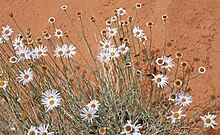Erigeron divergens is a species of flowering plant in the family Asteraceae known by the common name spreading fleabane. It is native to western North America.
| Erigeron divergens | |
|---|---|

| |
| Scientific classification | |
| Kingdom: | Plantae |
| Clade: | Tracheophytes |
| Clade: | Angiosperms |
| Clade: | Eudicots |
| Clade: | Asterids |
| Order: | Asterales |
| Family: | Asteraceae |
| Genus: | Erigeron |
| Species: | E. divergens
|
| Binomial name | |
| Erigeron divergens | |
| Synonyms[2] | |
| |
This plant is highly variable in form. It is an annual or perennial herb growing from a taproot and sometimes a caudex. It produces one to many stems 7 to 70 centimeters (3 to 27+1⁄2 inches) tall. It is a hairy plant, and the hairs are usually glandular, at least near the top of the stem. The basal leaves are 1 to 7 cm (1⁄2 to 3 in) long, and leaves higher on the stem are smaller. Flowering from April to September, the inflorescence can hold over 100 flower heads, each about 2.5 cm (1 in) wide.[3] The heads have 75 to 150 ray florets not more than 1 cm long which are white in color, fading purple, and sometimes absent. There are many yellow disc florets at the center. The fruit is seed-like and about 1 millimeter (1⁄16 in) long with bristles on the tip.[4][3]
The species exhibits agamospermy, asexual reproduction via seeds. Many, but not all, individuals are polyploid.[4] There are many similar species both inside and outside the genus.[3]
This plant can be found in the western half of the United States (as far east as western Texas),[3] the Canadian provinces of British Columbia and Alberta, and the Mexican states of Baja California, Chihuahua, Durango, Nuevo León,[5] and Sonora.[6][7] It occurs in many types of habitat, including desert shrublands and scrubs, grassland, meadows, pinyon–juniper woodland, oak and pine woodlands, riparian habitat, sagebrush, and disturbed areas.[4]
This plant had a number of uses in Native American traditional medicine. The Navajo used it as an aid in childbirth, as a lotion, an eyewash, and a treatment for snakebite and headache. It was a good luck charm among the Kiowa people.[8]

References edit
- ^ Tropicos, Erigeron divaricatus Nutt.
- ^ The Plant List, Erigeron divergens Torr. & A.Gray
- ^ a b c d Spellenberg, Richard (2001) [1979]. National Audubon Society Field Guide to North American Wildflowers: Western Region (rev ed.). Knopf. p. 371. ISBN 978-0-375-40233-3.
- ^ a b c Erigeron divergens. Flora of North America.
- ^ photo of herbarium specimen collected in Nuevo León in 1990
- ^ "Erigeron divergens". Germplasm Resources Information Network. Agricultural Research Service, United States Department of Agriculture. Retrieved 19 January 2018.
- ^ Biota of North America Program 2014 county distribution map
- ^ Erigeron divergens. Native American Ethnobotany. University of Michigan, Dearborn.
External links edit
- The Jepson eFlora 2013
- United States Department of Agriculture plants profile
- CalPhotos photo gallery, University of California
- Media related to Erigeron divergens at Wikimedia Commons
